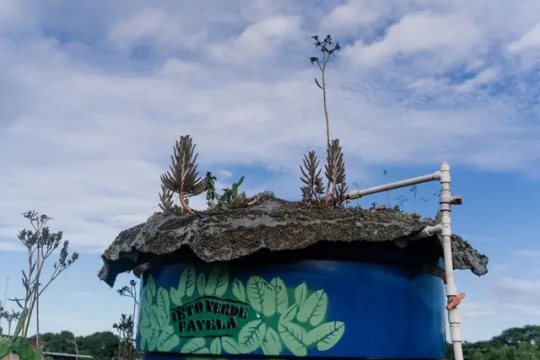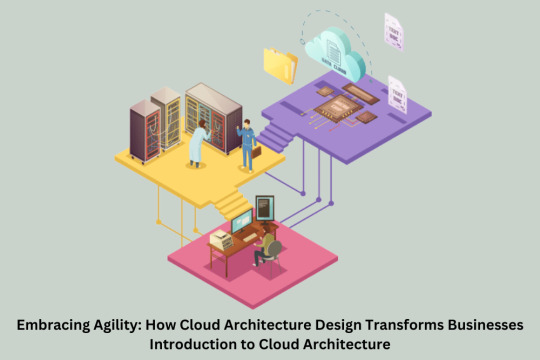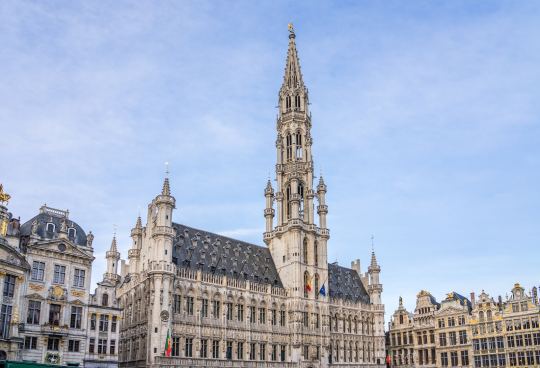#Infrastructure Adaptation
Explore tagged Tumblr posts
Text
Communications Systems Adaptations
As natural disasters intensify, our communication systems require fundamental transformation. There is an urgent need for resilient communication networks that can withstand environmental pressures. #ClimateAdaptation #CommunityResilience Adapting Communication Systems for an Uncertain Future The accelerating deterioration of Earth’s biosphere presents unprecedented challenges for maintaining…
#Climate Change#ClimateAdaptation#CommunityResilience#Disaster Preparedness#Emergency Communications#Infrastructure Adaptation#Resilient Networks
0 notes
Text


Pictured: Luis Cassiano is the founder of Teto Verde Favela, a nonprofit that teaches favela residents in Rio de Janeiro, Brazil, how to build their own green roofs as a way to beat the heat. He's photographed at his house, which has a green roof.
Article
"Cassiano is the founder of Teto Verde Favela, a nonprofit that teaches favela residents how to build their own green roofs as a way to beat the heat without overloading electrical grids or spending money on fans and air conditioners. He came across the concept over a decade ago while researching how to make his own home bearable during a particularly scorching summer in Rio.
A method that's been around for thousands of years and that was perfected in Germany in the 1960s and 1970s, green roofs weren't uncommon in more affluent neighborhoods when Cassiano first heard about them. But in Rio's more than 1,000 low-income favelas, their high cost and heavy weight meant they weren't even considered a possibility.
That is, until Cassiano decided to team up with a civil engineer who was looking at green roofs as part of his doctoral thesis to figure out a way to make them both safe and affordable for favela residents. Over the next 10 years, his nonprofit was born and green roofs started popping up around the Parque Arará community, on everything from homes and day care centers, to bus stops and food trucks.
When Gomes da Silva heard the story of Teto Verde Favela, he decided then and there that he wanted his home to be the group's next project, not just to cool his own home, but to spread the word to his neighbors about how green roofs could benefit their community and others like it.

Pictured: Jessica Tapre repairs a green roof in a bus stop in Benfica, Rio de Janeiro, Brazil.
Relief for a heat island
Like many low-income urban communities, Parque Arará is considered a heat island, an area without greenery that is more likely to suffer from extreme heat. A 2015 study from the Federal Rural University of Rio de Janeiro showed a 36-degree difference in land surface temperatures between the city's warmest neighborhoods and nearby vegetated areas. It also found that land surface temperatures in Rio's heat islands had increased by 3 degrees over the previous decade.
That kind of extreme heat can weigh heavily on human health, causing increased rates of dehydration and heat stroke; exacerbating chronic health conditions, like respiratory disorders; impacting brain function; and, ultimately, leading to death.
But with green roofs, less heat is absorbed than with other low-cost roofing materials common in favelas, such as asbestos tiles and corrugated steel sheets, which conduct extreme heat. The sustainable infrastructure also allows for evapotranspiration, a process in which plant roots absorb water and release it as vapor through their leaves, cooling the air in a similar way as sweating does for humans.
The plant-covered roofs can also dampen noise pollution, improve building energy efficiency, prevent flooding by reducing storm water runoff and ease anxiety.
"Just being able to see the greenery is good for mental health," says Marcelo Kozmhinsky, an agronomic engineer in Recife who specializes in sustainable landscaping. "Green roofs have so many positive effects on overall well-being and can be built to so many different specifications. There really are endless possibilities.""

Pictured: Summer heat has been known to melt water tanks during the summer in Rio, which runs from December to March. Pictured is the water tank at Luis Cassiano's house. He covered the tank with bidim, a lightweight material conducive for plantings that will keep things cool.
A lightweight solution
But the several layers required for traditional green roofs — each with its own purpose, like insulation or drainage — can make them quite heavy.
For favelas like Parque Arará, that can be a problem.
"When the elite build, they plan," says Cassiano. "They already consider putting green roofs on new buildings, and old buildings are built to code. But not in the favela. Everything here is low-cost and goes up any way it can."
Without the oversight of engineers or architects, and made with everything from wood scraps and daub, to bricks and cinder blocks, construction in favelas can't necessarily bear the weight of all the layers of a conventional green roof.
That's where the bidim comes in. Lightweight and conducive to plant growth — the roofs are hydroponic, so no soil is needed — it was the perfect material to make green roofs possible in Parque Arará. (Cassiano reiterates that safety comes first with any green roof he helps build. An engineer or architect is always consulted before Teto Verde Favela starts a project.)
And it was cheap. Because of the bidim and the vinyl sheets used as waterproof screening (as opposed to the traditional asphalt blanket), Cassiano's green roofs cost just 5 Brazilian reais, or $1, per square foot. A conventional green roof can cost as much as 53 Brazilian reais, or $11, for the same amount of space.
"It's about making something that has such important health and social benefits possible for everyone," says Ananda Stroke, an environmental engineering student at the Federal University of Rio de Janeiro who volunteers with Teto Verde Favela. "Everyone deserves to have access to green roofs, especially people who live in heat islands. They're the ones who need them the most." ...
It hasn't been long since Cassiano and the volunteers helped put the green roof on his house, but he can already feel the difference. It's similar, says Gomes da Silva, to the green roof-covered moto-taxi stand where he sometimes waits for a ride.
"It used to be unbearable when it was really hot out," he says. "But now it's cool enough that I can relax. Now I can breathe again."
-via NPR, January 25, 2025
#architecture#sustainable architecture#heat islands#urban heat#brazil#brasil#south america#favela#rio de janeiro#green roof#plants#climate action#climate adaptation#infrastructure#good news#hope#solarpunk
8K notes
·
View notes
Text
#good news#science#nature#environmentalism#environment#climate change#climate crisis#flooding#climate adaptation#climate resilience#city design#infrastructure
40 notes
·
View notes
Text
In the rich tapestry of botanical wonders, the Jujube Tree, scientifically known as Ziziphus jujuba or Jujube, emerges as a sweet symphony of natural splendor and cultural significance. This charming tree, adorned with small, sweet fruits and lush foliage, not only delights with its flavors but also holds deep-rooted cultural reverence. Join us on a journey through the enchanting world of the Jujube Tree, exploring its sweet treasures, cultural connections, and enduring legacy in traditional practices
#Adapting#agroforestry#Benefits#Biodiversity#Carbon Footprints#carbon sequestration#Children#Climate Change#conservation#Decarbonization#Environmental conservation#Forests#Future#green guardian#Green House Emissions#Green infrastructure#Indian#jujube#Oxygen#Plantation#Pollution#Reforestation#saveearth#Sustainable agriculture#Trees
2 notes
·
View notes
Text
Climate Resilience & Adaptability | Sustainability 8 of 31 | Study Hall
youtube
#climate change#resilience#adaptability#infrastructure#soil#ecology#agriculture#capitalism#economics#sustainability#Youtube
2 notes
·
View notes
Text
#Urbanization#Climate Change#Environmental Sustainability#Urban Resilience#Climate Mitigation#Climate Adaptation#Green Cities#Vulnerable Populations#Flooding#Drought#Air Pollution#Green Infrastructure#Renewable Energy
1 note
·
View note
Text
Embracing Agility: How Cloud Architecture Design Transforms Businesses
Introduction to Cloud Architecture In the contemporary landscape of technology, businesses are increasingly reliant on cloud services to propel their operations forward. Cloud architecture design has emerged as a pivotal element in this domain, offering scalable, flexible, and secure infrastructures that cater to diverse business needs. Crafting an efficient cloud architecture involves strategic…

View On WordPress
#Adaptive Cloud Solutions#Agile Cloud Solutions#Agility in Business#Business Transformation#Cloud Architecture Design#Cloud Infrastructure Evolution#Cloud Technology Impact#Digital Transformation Strategies#Embracing Agility#Future of Cloud Architecture#Innovations in Cloud Design#Strategic Cloud Implementation#Transformative Business Practices
2 notes
·
View notes
Text
How does one design architecture that promotes regional tourism and cultural exchange?
Designing Architecture that Promotes Regional Tourism and Cultural Exchange Introduction Designing architecture that promotes regional tourism and cultural exchange is a powerful way to showcase the unique heritage, traditions, and attractions of a region. Architecture plays a crucial role in creating memorable landmarks, immersive experiences, and vibrant spaces that draw tourists and facilitate…

View On WordPress
#adaptive reuse#architectural design#architectural festivals#cultural exchange#cultural heritage centers#cultural sensitivity#iconic landmarks#interpretive trails#local culture#regional tourism#site integration#sustainable design#sustainable tourism infrastructure#visitor experience
1 note
·
View note
Text
#Adapting#agroforestry#Biodiversity#Carbon Footprints#carbon sequestration#Climate Change#conservation#Decarbonization#Environmental conservation#Forests#Future#green guardian#Green House Emissions#Green infrastructure#Indian#Oxygen#Plantation#Pollution#Reforestation#saveearth#Sustainable agriculture#Trees
0 notes
Text
the hustle and bustle of our daily lives, the air we breathe often goes unnoticed. Yet, its quality is intricately linked to our well-being. In this exploration, we delve into the remarkable role that trees play in enhancing air quality and, consequently, our respiratory health.
#Adapting#banyan#Benefits#Biodiversity#Birds#Carbon Footprints#Children#cities#Climate Change#conservation#Decarbonization#elephant#Environmental conservation#Forests#Future#Gifting#Green House Emissions#Green infrastructure#Kids#miyawaki#Mother#mothers Day#Oxygen#Plantation#Pollution#Recent#Reforestation#Sustainable agriculture#Tiger#Tigers
2 notes
·
View notes
Text
https://growbilliontrees.com/blogs/knowledge/seeds-of-progress-unveiling-the-role-of-technology-in-tree-plantation
#Adapting#agroforestry#Benefits#Biodiversity#Carbon Footprints#carbon sequestration#Climate Change#conservation#Environmental conservation#Forests#Future#green guardian#Green House Emissions#Green infrastructure#Indian#Oxygen
0 notes
Text
Yup. Is overhauling our whole energy system and infrastructure to adapt to the new conditions of climate change gonna be expensive? Sure! But constantly rebuilding cities because they got wrecked by climate-fuelled extreme disasters is a lot more so. Anyway, we've got quite a few billionaires with more money than they know what to do with. Relieve them of most of it and we can probably cover a good chunk of the cost.

Mood.
#climate change#eat the rich#natural disasters#where things are destroyed we should be rebuilding to adapt#not recreating the same unsustainable infrastructure
5K notes
·
View notes
Text
#Adapting#agroforestry#Benefits#Biodiversity#Carbon Footprints#carbon sequestration#Climate Change#conservation#Decarbonization#Environmental conservation#Forests#Future#green guardian#Green House Emissions#Green infrastructure#Indian#Oxygen#Plantation#Pollution#Reforestation#saveearth#Sustainable agriculture#Trees
0 notes
Text
Bridging Smart City Visions and Budgets with a Construction Cost Estimating Service
As cities worldwide shift toward smarter, more sustainable development, the idea of a "smart city" has moved from aspiration to implementation. These urban environments are designed to leverage data, technology, and intelligent infrastructure to improve livability and efficiency. However, turning smart city concepts into real, functional spaces requires more than innovation—it requires precise financial planning. A construction cost estimating service plays a critical role in aligning bold urban visions with practical, achievable budgets.
Understanding the Smart City Framework
Smart cities are built on interconnected systems that include digital infrastructure, energy-efficient buildings, intelligent transportation, and real-time public services. Examples include sensor-based lighting, integrated data platforms, automated waste management, and green infrastructure.
Each element has financial implications, from high-tech installations to long-term maintenance. Cost estimating services help translate these visionary features into actionable plans by forecasting expenses across the project lifecycle.
Challenges of Budgeting for Smart Cities
Smart city projects pose several budgeting challenges:
Technology evolution: Rapid innovation can make systems obsolete mid-project.
Cross-sector integration: Combining infrastructure, software, and construction raises cost complexity.
Data infrastructure: Building digital backbones adds another layer of cost beyond traditional construction.
Long-term sustainability goals: Energy systems and green design often involve higher initial investment.
These challenges make it essential to include experienced cost estimators early in the planning process to anticipate and manage financial complexity.
Benefits of a Construction Cost Estimating Service in Smart City Projects
Translating Vision into Numbers
Convert abstract smart city features into quantifiable line items.
Include software, hardware, and systems integration costs.
Map budgets to both current needs and future scalability.
Balancing Innovation with Cost
Assess value versus cost for smart features like IoT devices or automated systems.
Identify areas where innovation yields the highest return.
Prevent overinvestment in tech that doesn't improve efficiency or performance.
Integrating Infrastructure and Digital Layers
Estimate costs for physical and digital components together.
Include broadband, sensor networks, and control centers in construction budgets.
Forecast long-term operational costs such as data storage, upgrades, and monitoring.
Scenario Modeling for Smart Alternatives
Compare options like smart HVAC vs. conventional systems.
Evaluate solar energy integration versus grid reliance.
Analyze smart parking systems against traditional parking infrastructure.
Creating Adaptable Budgets
Smart cities evolve constantly. What’s innovative today may need updating tomorrow. A construction cost estimating service develops flexible budgets that adapt to:
Phased implementations
Future technology upgrades
Changing regulations or codes
Shifting funding sources
This adaptive budgeting ensures that smart city initiatives stay on course—even in a changing environment.
Collaborating Across Stakeholders
Smart city developments involve a mix of partners:
Government agencies
Private tech firms
Utility companies
Community stakeholders
Cost estimators provide a unified financial picture that all stakeholders can understand. This helps build consensus and trust, especially when projects are funded by public-private partnerships.
Risk Management in Smart Infrastructure
The technical complexity of smart cities increases financial risk. A single system failure could disrupt multiple services. Cost estimators manage these risks by:
Including redundancy costs for critical systems
Building in cybersecurity considerations
Accounting for maintenance, system support, and service contracts
This forward-thinking approach supports not just the build-out of smart infrastructure, but its sustainable performance.
Cost Planning for Sustainable Smart Design
Sustainability is a pillar of smart cities, encompassing:
Energy-efficient building design
Renewable energy integration
Low-impact materials and construction
Green transportation systems
Estimating services align sustainability goals with realistic budgets by:
Forecasting ROI for sustainable features
Incorporating incentives, rebates, and tax credits
Calculating lifecycle cost savings versus upfront spending
Linking Digital Twin Technology with Budget Planning
An emerging tool in smart cities is the "digital twin"—a real-time virtual model of the physical city. These systems help manage infrastructure more efficiently but come at a significant cost.
Cost estimators help:
Quantify the setup and operational cost of digital twins
Align them with existing construction and infrastructure budgets
Model upgrade paths and maintenance needs
This integration ensures the technology’s benefits are achieved without undermining financial feasibility.
Planning for Scalability and Future Growth
Smart cities are designed to grow. Estimators help projects prepare for future demands by:
Including scalable systems in original budgets
Creating allowances for future construction phases
Modeling per-capita infrastructure costs based on projected growth
This long-term outlook prevents underinvestment and supports urban resilience.
Conclusion
Smart cities represent the future of urban living—data-driven, energy-efficient, and responsive to the needs of their populations. But without detailed financial planning, these projects risk becoming too expensive, overly complex, or disconnected from reality.
A construction cost estimating service brings structure and clarity to the process. By accurately forecasting the cost of innovation, integration, and long-term performance, it enables urban planners, engineers, and policymakers to turn smart city concepts into budget-aligned action. In a world where cities must be both intelligent and sustainable, the foundation of success begins with smart estimating.
#smart city#cost estimating#budgeting#urban planning#digital infrastructure#IoT construction#energy efficiency#green building#public-private#lifecycle cost#sustainable urbanism#infrastructure cost#data networks#smart HVAC#digital twins#city design#modular systems#cost forecasting#stakeholder alignment#smart mobility#green infrastructure#urban innovation#adaptive budgets#risk management#maintenance cost#cost modeling#urban resilience#construction pricing#funding strategies#scalable systems
0 notes
Text
Hybrid Small Modular Reactors (SMRs): Pioneering the Future of Energy and Connectivity
SolveForce is proud to announce the release of a groundbreaking new book, “Hybrid Small Modular Reactors (SMRs): From Design to Future Technologies,” co-authored by Ronald Joseph Legarski, Jr., President & CEO of SolveForce and Co-Founder of Adaptive Energy Systems. This publication stands at the convergence of next-generation nuclear energy, telecommunications infrastructure, and digital…
#Adaptive Energy Systems#AI in Energy#Cybersecurity#Data Center Energy Solutions#Digital twin#Energy and Telecom Integration#Energy Storage#Energy Sustainability#Fiber Optics#Fusion-Fission Hybrids#Grid Optimization#Hybrid SMRs#Hydrogen from SMRs#Lead-Cooled Reactor#Modular Energy#Next-Gen Reactors#Nuclear Book Release#Nuclear Energy#Nuclear Innovation#Reactor Safety#Recycled Nuclear Fuel#Ron Legarski#Small Modular Reactors#Smart Grid#smart infrastructure#SMR Deployment Strategies#SMR Design#SolveForce#Telecommunications#Yash Patel
0 notes
Text
How does one address the social and economic needs of a region through architectural interventions?
Addressing the Social and Economic Needs of a Region through Architectural Interventions Introduction Architectural interventions have the power to address the social and economic needs of a region by creating built environments that cater to the well-being and prosperity of the community. Beyond the functional aspects, architecture has the potential to shape social interactions, enhance…

View On WordPress
#accessibility#adaptive reuse#affordable housing#architectural interventions#community engagement#community facilities#contextual sensitivity#economic needs#flexible spaces#green infrastructure#inclusivity#mixed-use developments#public spaces#social needs#sustainable design
1 note
·
View note